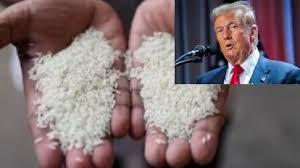Trump threatens Japan with new tariffs, says it refuses to buy American rice

Former U.S. President Donald Trump has reignited trade tensions, this time targeting Japan with new tariff threats. His criticism centers on Japan’s approach to importing American rice. Trump claims Japan refuses to buy U.S. rice despite facing a domestic shortage. This threat arrives ahead of a key trade deadline on July 9, when tariff rates could sharply rise if no new agreements are reached.
Trump’s Warning: Buy Our Rice or Face Consequences
On June 30, Trump posted on Truth Social, accusing Japan of neglecting American farmers. He said, “They won’t take our RICE, and yet they have a massive rice shortage.” He warned that if talks do not progress, Japan will receive a letter outlining new tariff rates. This comment fits into a broader strategy to pressure trading partners before the expiration of a temporary tariff pause.
The U.S. government plans to lift the current trade relief, which kept tariffs at lower levels. After July 9, tariff rates could increase to as much as 50% on certain goods. Trump’s message serves as both a warning and a political move to rally support from American agricultural regions.
Japan’s Response: No Compromise on Farmers
Japanese officials quickly responded, defending their policies. They emphasized that Japan won’t sacrifice its agricultural sector, especially rice farmers. The government stated that it already allows 770,000 metric tons of rice to enter under World Trade Organization (WTO) rules. Of that, about 100,000 tons are set aside for staple rice, including imports from the U.S.
Recently, Japan bought 25,541 tons of American rice through a tender process. This shows that Japan continues to purchase U.S. rice within the agreed limits. However, officials made it clear they won’t open the market further at the expense of domestic farmers. In Japan, rice is not just a crop—it is tied to cultural identity and rural political influence.
A Larger Trade Puzzle
The rice issue is only one piece of a much bigger trade puzzle. Several nations, including Japan, are racing to secure agreements before July 9. Without a deal, new tariffs may take effect, targeting sectors like automobiles, steel, and technology.
U.S. Treasury Secretary Scott Bessent confirmed that affected countries will receive official letters listing their new tariff rates. Japan, in particular, is anxious about the 25% tariff on car exports to the U.S.—a critical part of its economy. While rice has taken center stage, the auto industry remains the most sensitive topic.
Why Rice Matters So Much
To many, rice may seem like an odd trigger for a trade dispute. However, it carries major political weight in both countries. In the U.S., rice farmers in Arkansas, California, and Louisiana have long pushed for better market access. For them, Japan’s tightly protected rice sector feels unfair.
Japan, on the other hand, sees rice as part of its national identity. The government controls rice prices, limits imports, and supports small farmers. Imported rice mostly goes toward processed foods, emergency stockpiles, or fulfilling trade quotas—not daily meals.
Trump’s claims that Japan “refuses” U.S. rice simplify a complicated system. While there are restrictions, Japan continues to buy American rice through official channels. Still, this issue resonates with Trump’s voter base, making it an easy target.
Countdown to July 9
The July 9 deadline looms large. If negotiations fail, U.S. tariffs will jump for countries without updated trade terms. Japan could face higher duties on cars, electronics, and other exports.
Japan wants to avoid this outcome but must tread carefully. The government doesn’t want to anger domestic farmers or appear weak on trade. It may offer limited concessions, but full liberalization of rice imports is unlikely.
Experts warn that escalating the rice issue could stall cooperation in more critical areas. Both nations need each other for supply chain security, digital trade, and semiconductor collaboration.
Political Calculations Behind the Dispute
Trump’s approach is not just economic—it’s political. By reviving trade issues, he strengthens ties with rural voters and American manufacturers. His criticism of Japan plays well in parts of the U.S. where trade imbalances and foreign competition remain hot topics.
Japan’s government must also consider domestic politics. Farmers make up a strong voting bloc. Any policy seen as favoring U.S. demands could damage public support. The current leadership wants to preserve trade ties without sacrificing its agriculture.
Conclusion: Small Grain, Big Consequences
This dispute over rice goes beyond agriculture. It’s a symbol of bigger tensions around protectionism, national identity, and trade fairness. As the July 9 deadline nears, both nations face a tough choice—stand firm or compromise.
The outcome of this rice row could shape the next chapter of U.S.-Japan trade. While the grain itself may seem small, the stakes for diplomacy, economy, and politics are enormous.






